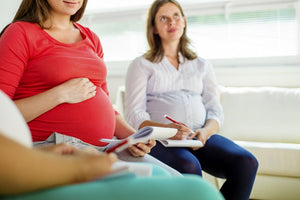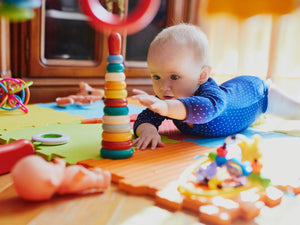Pregnancy is an exciting and rewarding experience, but it also comes with plenty of new responsibilities. One of those responsibilities is making sure to look after yourself before, during and after your pregnancy.
Treating your body correctly can have a dramatic effect on your experience of pregnancy, labour and birth. Making time to attend antenatal classes is a great way to learn about the changes to your body and what you need to do to manage your pregnancy. Pelvic floor exercises are a common part of online antenatal classes. In just a few minutes a day, pelvic floor exercises can transform the way your body handles pregnancy and prevent you from developing ongoing issues after giving birth.
What Are Pelvic Floor Exercises?
The pelvic floor is a layer of muscle tissue that stretches from the front of your pubic bone to the lower end of your backbone. These muscles play an important role in several bodily functions, and weak muscles can cause you to leak urine when coughing, sneezing or straining (known as stress incontinence). While this is perfectly normal for lots of women, it’s an issue that can be both frustrating and stressful. Consult your healthcare provider if you’re concerned about pelvic floor health or stress incontinence.
Pelvic floor exercises are just like the exercises you would do for other parts of your body. By straining the muscles slightly you can build up their strength and resistance, making them more effective for things like holding your urine and supporting your bladder, uterus and bowel.
When Should You Do Pelvic Floor Exercises During Pregnancy?
Pelvic floor exercises are simple and non-strenuous, meaning they are perfectly safe to perform at any time. Ideally, women should do pelvic floor exercises before, during and after pregnancy. Even for those who are young and aren’t experiencing side effects like stress incontinence, working out the pelvic floor can help you avoid issues post-pregnancy.
How to Do Pelvic Floor Exercises
Pelvic floor exercises are easy to do. For best results you should incorporate the exercises into your daily routine for the rest of your life. Even if you’re young and not experiencing any problems now, pelvic floor exercises can help you avoid issues after giving birth and later in life.
The exercise itself is simple. A pelvic floor workout can be done while sitting, standing or lying down:
- Squeeze the muscles around your anus and vagina at the same time - this is the same muscle group you squeeze to hold onto urine. You shouldn’t be clenching your buttocks or thighs.
- Hold the squeezed muscles in place and count to 8.
- Release the muscles and relax for 8 seconds.
- Repeat the squeeze and hold exercise - ideally for 3 sets of 8 to 10 squeezes each day.
Don’t worry if you can’t squeeze for 8 seconds. Just hold it for as long as you can and focus on doing the exercises regularly. Remember to keep breathing while doing the exercise.
Preventing Damage to Your Pelvic Floor Muscles
Pelvic floor exercises are a simple and effective way of strengthening your pelvic floor muscles. If you can get into the habit of doing your exercises each day then it will be simple to keep those critical muscles in great condition. But there are a few things you can do to avoid damaging your pelvic floor muscles:
- Eat high-fibre foods and drink plenty of water to avoid constipation
- Limit the amount of heavy lifting you do
- Avoid continuous coughing or straining - tighten your pelvic floor muscles when you feel a cough or sneeze coming
- Maintain a healthy body weight
- Make pelvic floor exercises a regular part of your life
Learn About Pelvic Floor Exercises with Online Antenatal Classes from Nourish Baby!
Pelvic floor exercises are a simple and easy way to look after your pelvic floor and avoid issues like stress incontinence. Especially if you are pregnant, planning to become pregnant or have just given birth, it’s a good idea to make these simple exercises part of your daily routine. If you would like to find out more, explore Nourish Baby’s selection of online antenatal classes today! Our online antenatal classes provide all the same information you would get from an in-person class, but it’s available online at your convenience. We provide a range of online courses and our guide for new parents is designed to support pregnant parents at every stage of the journey. For more information you are welcome to contact us and speak to our team!
References:
The Women's - The Royal Women's Hospital
Hillary Schwantzer, Women's Health Physiotherapist.
Our Products
-

01. Guide to a Healthy Pregnancy
$55 -

02. Positive Birthing Course
$55 -

03. Infant Feeding Guide
$55 -

04. Baby Sleep Guide - First 12 Months
$55 -

05. Toddler Parenting Course 1 - 3 Years
$55
-
 When to Start Antenatal Classes?
When to Start Antenatal Classes?
Becoming a parent is an incredible milestone, but it comes with a host of changes that can be daunting, especially for first time parents. Antenatal classes are all about offering expectant parents the education they need to make informed decisions, look after their bodies and care for their newborn babies. While you probably already have a long list of things you need to accomplish during your pregnancy, it’s a good idea to make time to attend antenatal classes.
-
 Development Milestones 4-8 Months
Development Milestones 4-8 Months
As they reach the middle of their first year, you'll start to see bigger leaps in their growth and ability!
In this article, we’re going to discuss your baby’s developmental milestones between 4-8 months, and what you can expect along the way.





 When to Start Antenatal Classes?
When to Start Antenatal Classes?
 Development Milestones 4-8 Months
Development Milestones 4-8 Months








